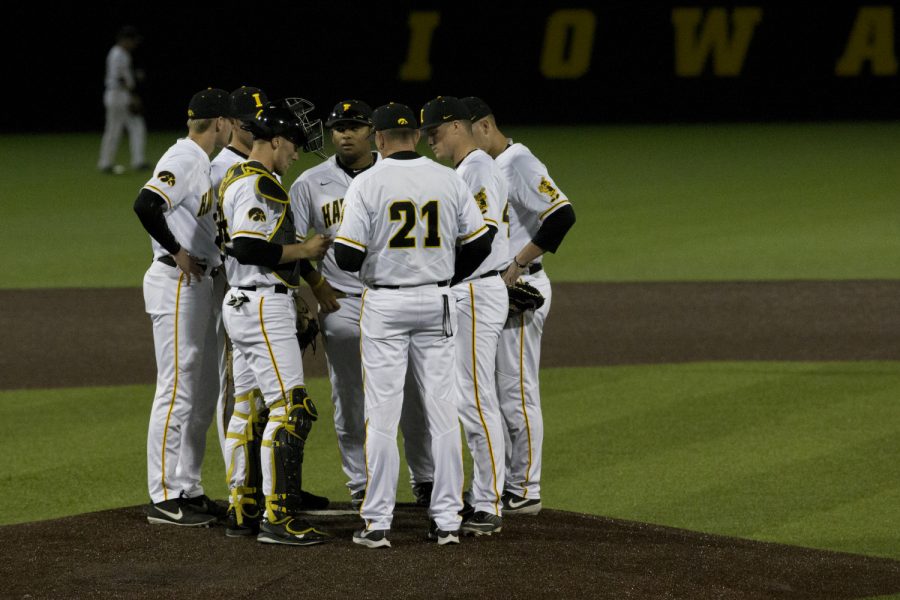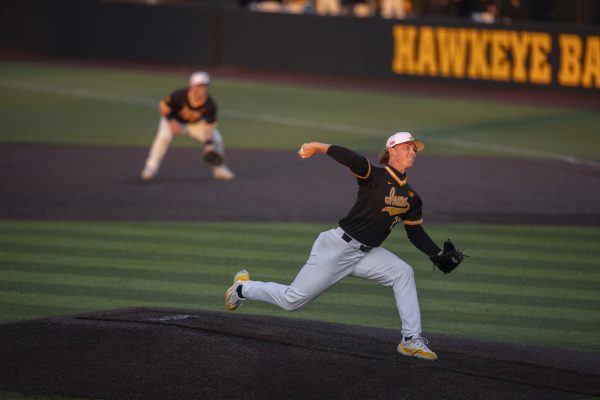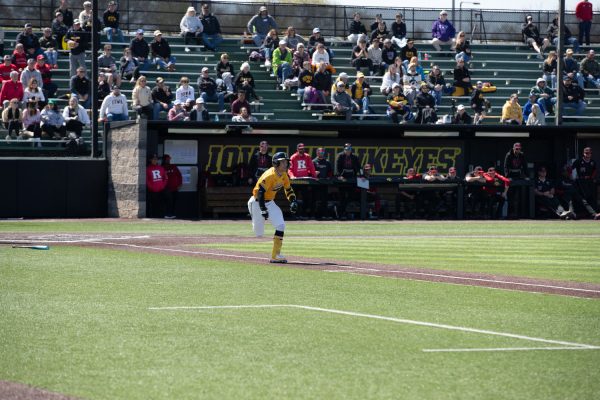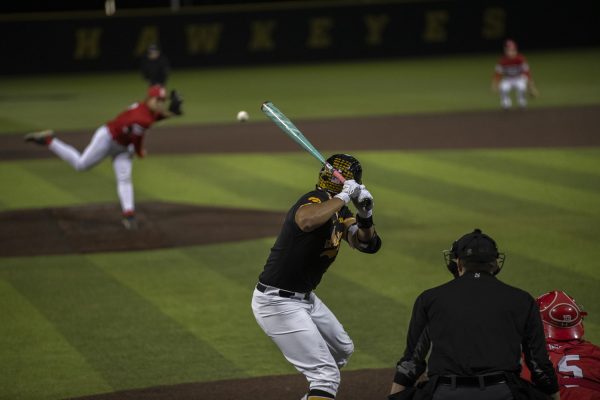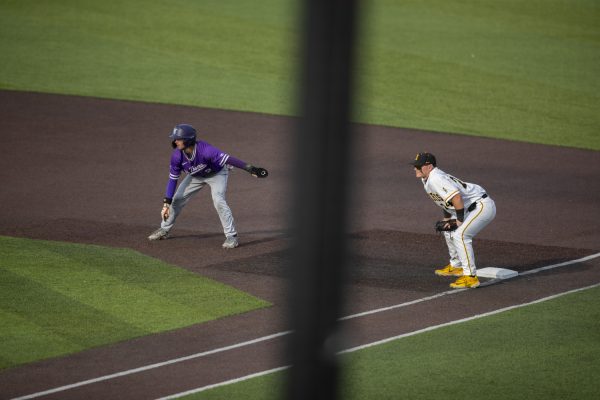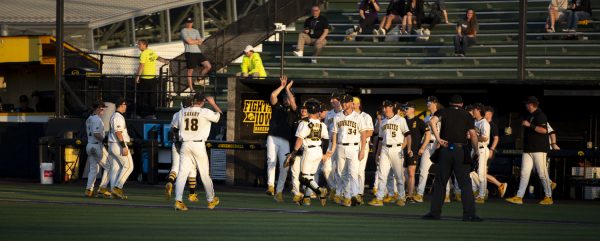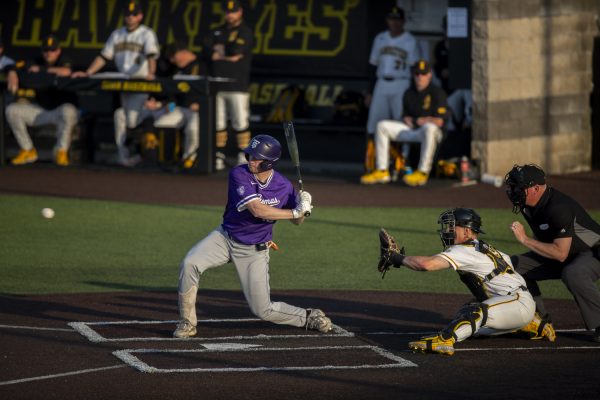Baseball coach Rick Heller explains impact of NCAA’s blanket waiver on Iowa for 2021 season
The NCAA Division I Committee for Legislative Relief announced after the season’s cancellation a blanket waiver that includes temporary rule changes in order to give relief to college baseball.
Hannah Kinson for The Daily Iowa
Iowa players meet on the pitcher’s mound during the game against Michigan State at the Duane Banks Baseball Stadium on Friday, May 10, 2019. The Hawkeyes defeated the Spartans 7-5.
July 23, 2020
Most of the college baseball season was canceled in 2020 because of the COVID-19 pandemic, and some elements of the season will still look different in 2021.
Following the cancellation of the season, the NCAA Division I Committee for Legislative Relief announced that teams would receive a blanket waiver for the 2020-21 academic year. The waiver has met requests from the American Baseball Coaches Association and the different college conferences.
The three important rule changes include:
- Elimination of the varsity squad size limitation
- Increase the annual counter limit from 27 to 32
- Allowing the renegotiation of athletic aid agreements to provide less than 25-percent scholarship
In a typical year for college baseball, varsity roster sizes would be capped at 35 student-athletes. However, with seniors receiving an extra year of eligibility and many opting to return to school due to the shortened MLB draft, this limitation has been removed to make room for their return and the incoming freshman class’s arrival.
“I think all of us were really scared with what was going to happen if we didn’t get relief, but we did feel somewhat optimistic that relief would be given,” Iowa baseball head coach Rick Heller said. “With the original rules, you were going to be backed into a corner where your only option was to try to have guys move on.”
Each college baseball program is allowed to offer a maximum of 11.7 scholarships. The counter limit refers to the maximum number of players that the program can divide these 11.7 scholarships amongst.
RELATED: Spring-sport athletes to receive extra year of eligibility, winter-sport athletes denied
The counter limit set by the NCAA is usually 27, but the waiver has now raised that limit to 32 in order to spread the money around to other players and ensure that freshmen receive scholarships.
“You will see others across the country who will take advantage of it and just try to sign more players and get rid of guys who are not as good, unfortunately,” Heller said. “In our situation, we are just trying to manage our roster and keep it as close to the normal numbers and make sure everyone is taken care of who needs to be taken care of in our program right now.”
The removal of the roster cap and the increase in the counter limit from 27 to 32 were prongs of a proposal made by the ABCA. The removal of the 25-percent scholarship minimum was a separate request made by the Pac-12 Conference.
Programs can now renegotiate athletic aid agreements to provide less than 25-percent scholarship for certain players and offer players a scholarship less than 25 percent for this year only. While this could impact the amount of returning scholarship players at other programs, Heller said that it will not adversely affect any Iowa players.
“What it does is, if there was extra money leftover like 15 percent or 20 percent, you could split that up between two players or three players,” Heller said. “Whereas before you could not even offer that scholarship, and you would have to eat that money or give it to a player that already had a bigger scholarship because every scholarship had to be 25 percent.”
RELATED: Iowa baseball players miss out on opportunities due to shortened MLB Draft
Other institutions have called for this 25-percent scholarship rule change to become permanent with the belief that if a player is willing to come to their school for less than 25 percent, then they should be allowed to do so.
Coaches, including Heller, have said that they like this rule, as it allows for mid-major programs to have an impact on the sport. Prior to the rule being passed in 2008, major schools with the largest budgets and the most name recognition were able to hoard a lot of the top talent.
“In a normal circumstance, I like the 25-percent rule because what the 2-percent rule and the roster cap do is that they don’t let teams hoard players,” Heller said. “Being a guy who has done this a long time and spent several years seeing the abuse of not having a 25-percent rule, I am in favor of the 25-percent rule under normal circumstances.”
With the return of more seniors and a strong recruiting class full of players who otherwise would have gone to the MLB draft had it not been shortened to five rounds, college baseball is looking at one of its most talent-rich seasons ever.



